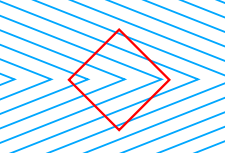Difference between revisions of "Orbison illusion" - New World Encyclopedia
(Started) |
({{Contracted}}) |
||
| Line 1: | Line 1: | ||
| − | {{Claimed}}{{Started}} | + | {{Claimed}}{{Started}}{{Contracted}} |
[[Category:Politics and social sciences]] | [[Category:Politics and social sciences]] | ||
[[Category:Psychology]] | [[Category:Psychology]] | ||
Revision as of 16:31, 17 September 2007
The Orbison illusion is an optical illusion that was first described by the psychologist William Orbison in 1939. The bounding rectangle and inner square both appear distorted in the presence of the radiating lines. The background gives us the impression there is some sort of perspective. As a result, our brain sees the shape distorted. This is a variant of the Hering and Wundt illusions.
ReferencesISBN links support NWE through referral fees
- R. N. Shepard, Mind Sights, W. H. Freeman and Company, 1990
- A. Seckel, The Art of Optical Illusions, Carlton Books, 2000 (#126)
- The Mind's Eye, Readings from SCIENTIFIC AMERICAN, W. H. Freeman and Company, 1986
External links
Credits
New World Encyclopedia writers and editors rewrote and completed the Wikipedia article in accordance with New World Encyclopedia standards. This article abides by terms of the Creative Commons CC-by-sa 3.0 License (CC-by-sa), which may be used and disseminated with proper attribution. Credit is due under the terms of this license that can reference both the New World Encyclopedia contributors and the selfless volunteer contributors of the Wikimedia Foundation. To cite this article click here for a list of acceptable citing formats.The history of earlier contributions by wikipedians is accessible to researchers here:
The history of this article since it was imported to New World Encyclopedia:
Note: Some restrictions may apply to use of individual images which are separately licensed.
